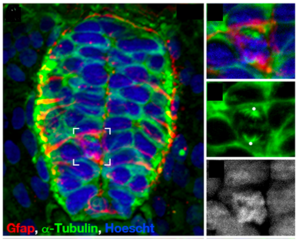Why study radial glia development?
Whether in fish or humans, radial glial cells provide several essential functions to how the vertebrate brain is built. Radial glia serve as the neural stem cell of the embryo, providing the generative power to make both neurons and glial cells as the brain expands and diversifies. Radial glia have a long cellular extension that spans the full length from innermost to outermost portions of the brain. This structure provides a scaffold for which other cells use as a substrate and become organized upon. The peripheral most process of the radial glial cells also serves to establish the first barrier to tissues outside the CNS (think blood-brain-barrier).
These and other functions make radial glia one of the most important cell types in the developing brain. It is thus not surprising that misregulation of radial glial is attributed to the origin of most congenital cancers as well as contributes to the pathology associated with a variety of neurological disorders.
We have identified a pair of genes called meteorin and meteorin-like that encode putative signaling proteins, which we hypothesize function as important regulators of the radial glial development. This project team is currently attempting to make gene-knockouts and transgenic reporter fish lines to help us characterize the roles that they play in radial glial development and beyond.
